This post is one in a series of making small adjustments to a single recipe in order to improve it, learn more about the impact each ingredient has on the finished product, and the art of recipe creation. The rest of the comparison tastings in this series can be found here.
The most interesting of these comparisons for me are the ones that are only one version away from each other. The variation of the final product caused by changing one element in this red IPA recipe has not ceased to surprise me.
Recap
The differences between versions 5 and 6 of this recipe are a bit harder to follow in the bullet point format I’ve used before, simply because differences in a hop schedule are easier to see as a recipe than they are to explain. The recipes for each are as follows:
|
Iteration 5
|
Iteration 6
|
Appearance
Both Iterations 5 and 6 had an amber hue, but Iteration 6 was clearer. Iteration 5 had a moderate head with moderate retention. Iteration 6 had minimal had with moderate retention (what little there was had decent staying power).

Aroma
Iteration 5 smelled of plum and citrus—more strongly of plum though. While I got those same notes from Iteration 6 as well, the strength of each was flipped. Iteration 6 also had a hint of cattiness.
Flavor
Iteration 5 had citrus, floral, cherry, and plum notes. It was also quite bitter. While it was still fairly cold, the flavors seemed muddled. When it had the chance to warm up, though, the perceived bitterness was less harsh and the previously muddled flavors rounded out to a pleasant richness.
Iteration 6 tasted of cherry, citrus, and plum, carrying (again) a hint of cattiness with it. There was less perceptual bitterness than Iteration 5 (despite having a higher estimated IBU). The flavor was also crisper than Iteration 5.
Final Thoughts
I speculated on the lack of clarity in my beers before, and it was interesting to see another of my beers that had been cloudy show itself to be clearer than before. I will admit that after pouring my glass of Iteration 5 and getting some yeast in the glass, I was more careful with the next pour, and I’m wondering if the answer to my clarity issues is really that simple. Probably. More beers will tell.
The difference in aroma between these beers is unsurprising due to moving Simcoe from 60 and 30 minute additions to the 0 minute mark and using it as a dry hop. The cattiness that is present in Iteration 6 (but not 5) is a clear indicator of what is commonly touted about hop aroma and timing in the boil. The flip in malt/hop aroma in terms of strength is also unsurprising because of the difference in age. One month really does make that much of a difference, it would seem.
Despite adding 3 more ounces of C120 to the malt bill of Iteration 6 for the sole purpose of adjusting the color, there was no difference in color. I did, however, yield a greater post-boil volume in Iteration 6, so I believe this to be the cause.
The biggest differences surprises to me, I think, are stemming from the same place: the difference in OG/ABV. My initial thoughts on the richness of Iteration 5 that is lacking in Iteration 6 is that the higher ABV is thinning out what malt richness is there (as they finished at similar gravities). Despite the higher OG in Iteration 6 (and the subsequent, seemingly logical, assumption on my end that higher gravity should correspond with more malt depth), the lower ABV version of this beer has a greater richness. It is possible there’s another cause besides a thinning effect of alcohol, but if there is I simply haven’t thought of it yet.
The other big difference that’s worth noting is the disparity in perceived bitterness. Iteration 5 had an almost harsh bitterness that was very prominent. Despite a higher estimated IBU, Iteration 6 had a smoother bitterness and seemed less bitter overall. Three possibilities spring to mind here. One could be that the higher OG lowered my hop utilization rate, but with a 10 point gravity difference and a 14 point IBU difference, I can’t imagine it would be the only factor at play. Another possibility is that Simcoe has a harsher bitterness character than magnum when used early in the boil; however, since earlier iterations did not have this same harshness, I feel inclined to ignore this. The bitterness to gravity ratio seems to be a more likely cause here. Higher OG would balance out the higher bitterness and produce a seemingly smoother bitterness that was not as prominent on the palate, despite there being more of it.
